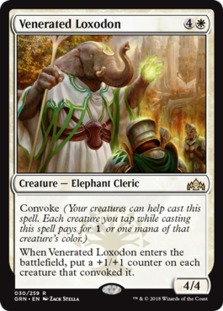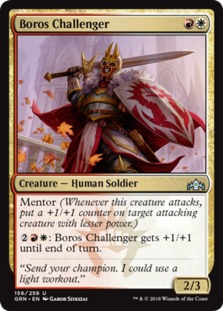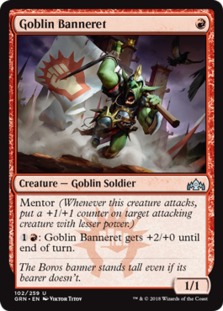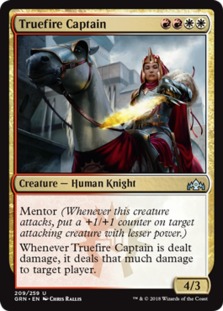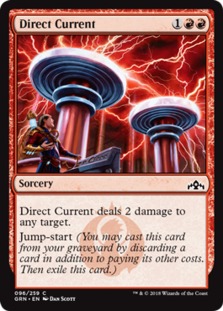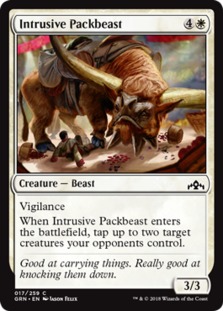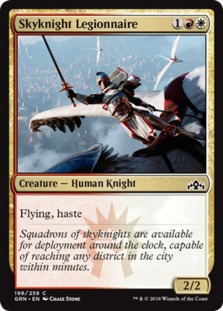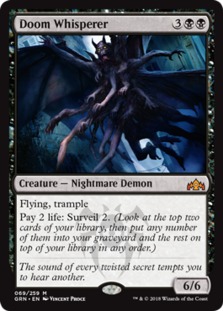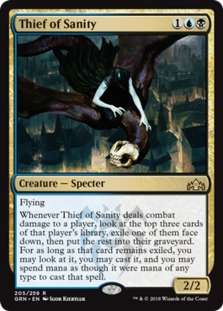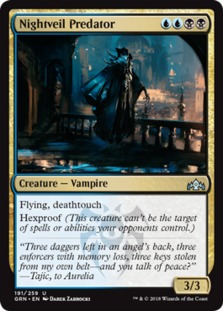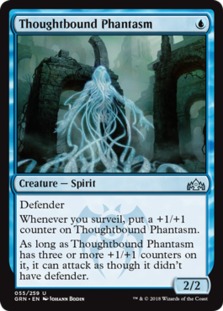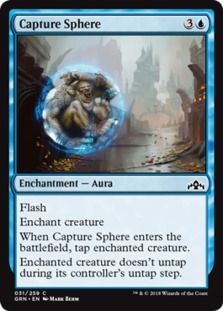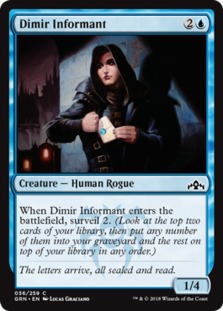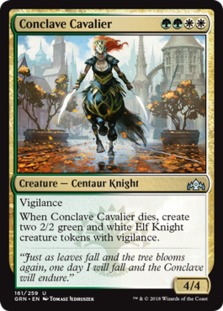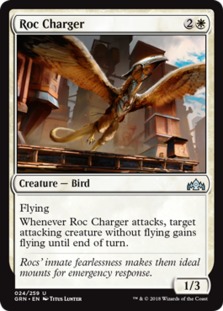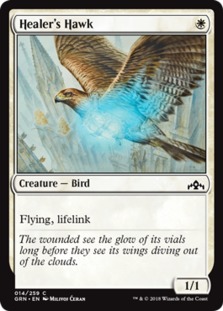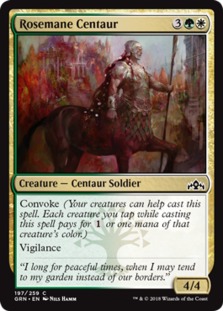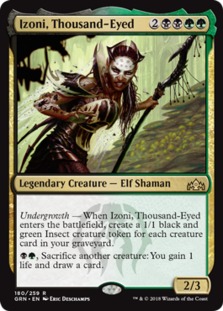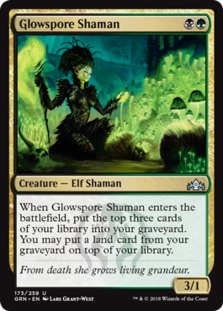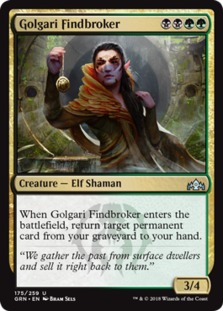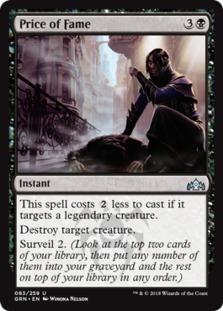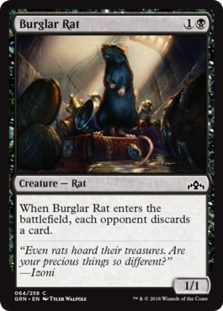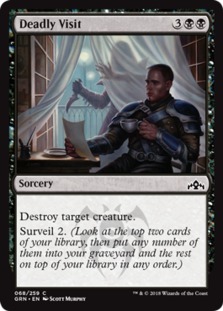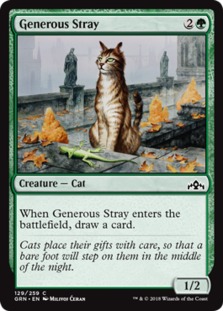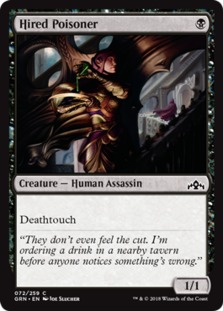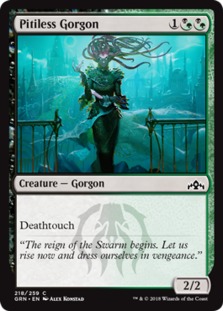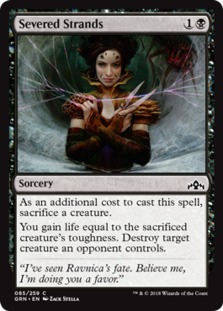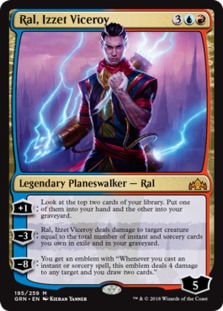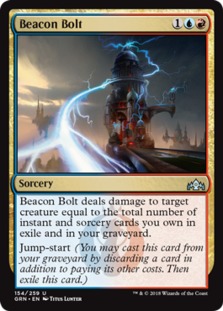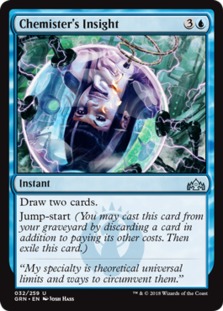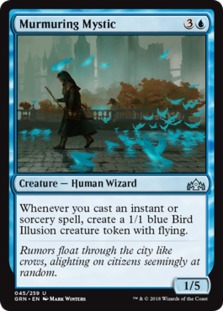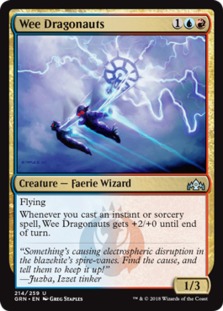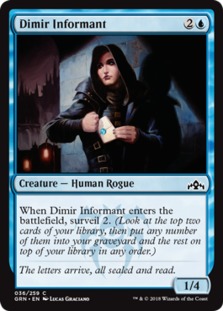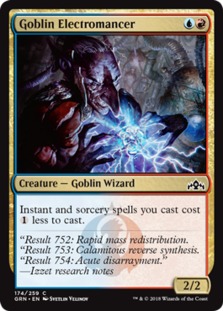Table of Contents
Guilds of Ravnica is back briefly first time as a Premier Draft on Magic Arena, so I think it is a good time to take a fresh look at the format. After discussing the key features of GRN I will get into ranking the archetypes and identifying the best common and uncommon cards to play in each.
Overall, I think this set was a huge missed opportunity because the mechanics and flavor for each color combination is on point. It just feels like the playtesting phase didn’t do enough to iron everything out. The most glaring issue to me is you are forced pretty hard to draft the two-color guilds. While they fixed this in the sister set Ravnica Allegiance with solid three-color combinations and gate-themed decks, Guilds of Ravnica completely lacks these features.

In Guilds of Ravnica the three-color combinations just don’t work out naturally. You have Boros and Selesnya as the primary ‘go-wide’ creature decks and to splash a 3rd color you would be adding Blue and Black, respectively. The payoff just isn’t there to add those colors to aggressive decks. You could combine Boros and Selesnya into a RGW deck, but many of the best cards are double costed and there are almost no payoffs to justify playing tapped gate lands in an aggro deck.
On the other side you have Dimir as a control archetype that would need to splash Green or Red to access a second guild, which creates some really clunky combinations. While I have opened Chamber Sentry p1p1 and built some decent 4-5 color ‘good stuff’ decks, I wouldn’t exactly consider that an archetype.
Couple this with the fact that two of the guilds (Boros and Dimir) are significantly overpowered, and it becomes understandable why GRN is widely considered a poor Limited environment. Still, it is far from unplayable and can be quite fun, Guilds just lacks the diversity of archetypes we have been enjoying from Ravnica Allegiance on.
Event Details
The Format
What we have here is a pretty rock-paper-scissors limited environment:
- Aggro – Boros (RW) – Mentor Mechanic (Mentor creatures attack and provide a +1/+1 counter to a weaker creature).
- Midrange – Selesnya (GW) – Convoke Mechanic (Tap your creatures as mana to play convoke spells).
- Control – Dimir (UB) – Surveil Mechanic (Scry except send cards to your graveyard instead of the bottom of your library)
- Combo – Izzet (UR) – Jump-start Mechanic (cast spells from graveyard by discarding a card) and Golgari (BG) – Undergrowth Mechanic (Undergrowth cards get a bonus based on the number of creatures in your graveyard).
No, Izzet and Golgari aren’t exactly ‘combo decks,’ but the issue is there isn’t enough support for them in the set. Jump-start cards pay off over time but Izzet wasn’t given enough tools to reliably stay alive or threaten the opponent enough to get that time. Golgari has some solid payoff cards for having creatures in your graveyard, but it can be challenging to get them in there without giving away card advantage. Both Izzet and Golgari can still be built into strong decks that can absolutely go off and win games, but their mechanics are so situational that consistency is a problem. Since this is the classic problem of Combo decks, I labeled them as such.
Now, let’s look at some of the key features of the format:
- There are many Bombs – These are rares that can win games almost single-handedly. It is important to build around these when you see them so I am going to identify a few for each archetype when I get into those reviews. The majority of them are archetype-specific, so opening one will often lock you into an archetype early. This dynamic tends to lower the skill ceiling is yet another mark against GRN Draft.
- Removal is average – This makes those bombs more powerful and Aggro decks stronger. Unfortunately a lot of the good removal is guild-specific.
- Evasive creatures are flyers – There are a lot of flying creatures in the format, and several of them are aggro-oriented.
- Creatures are average – There are a lot of 2 mana 2/x creatures with abilities and creatures that cost a mana extra than usual but have a strong ability (draw a card, surveil, tap down creatures, etc..). The Mentor and Convoke mechanics help to get even more value out of creatures, however.
- The format is fairly fast – There are a lot of decks capable of curving out into strong creatures by 3rd or 4th turn. Even Dimir (the control archetype) has low curve uncommons that can become strong quickly and pressure opponents.
Next, I will be breaking down the guilds. I have already alluded to this, but basically there are two tiers of guilds. The ‘Tier 2’ guilds can certainly be strong with the right cards and synergy, but on average they are noticably worse than the Tier 1 guilds. The most important thing is identifying the key cards in your drafts and building your decks in a way that plays to the strengths of your chosen archetype. My objective in this section is to help you select these key cards and understand how they work together to maximize synergy.
Tier 1 Guilds
I sure hope you like Boros and Dimir, because it is about 80% of what you are going to see on Arena. While these two are very powerful, it isn’t always going to be correct to draft them, so as usual I do not recommend ‘forcing’ archetypes.
Boros (RW)
Boros is ridiculously consistent and doesn’t require many rares/uncommons to go off. The mentor mechanic is insanely powerful in limited, blowing out unprepared opponents and grinding out value over time in many situations. There are also multiple ways at common to prevent your opponents from blocking, so even if opponents stabilize completely you still have outs. I do not think Boros is so broken that it should be forced over everything else, but it is a deck that can be built relatively easily and still find success with.
Bomb Rares
Aurelia is nuts and a surefire reason to draft Boros. Legion Warboss is a great snowball card and Boros has a lot of ways to take advantage of him. Venerated Loxodon is a bomb here or in Selesnya, but I actually think it is better in this archetype. The +1/+1 counters work really well with mentor creatures, and you will often be able to cast him as a 4/4 on turn 3 while buffing your 1 and 2 drops.
Best Uncommons
Boros has a suite of awesome cards to choose from at this rarity. Oddly enough I tend to get most excited about drafting Boros Challenger, because one of the bottlenecks Boros tends to face is getting stuck with multiple 2/2 mentor creatures and not having a way to buff them. Paying 4 mana for +1/+1 may seem like a lot, but having that option provides an essential tool for the archetype. Goblin Banneret also helps with that problem as you will typically use him to get your mentor creatures up to 3 power and then he will trade, which is well worth it! Boros has two of the best removal spells in Intervention and Justice Strike. Lava Coil and Conclave Tribunal are excellent removal options as well. Truefire Captain is a bomb but the casting cost can be prohibitive sometimes in an archetype where you don’t want gates and often cut down to 16 lands. Of the nine I am lowest on the Guildmage and wouldn’t take her over something like Sunhome Stalwart (another great card), but both guildmage abilities are relevant to the Boros game plan.
Important Commons
You truly get the complete Boros package at common in this set. Healer’s Hawk, Skyknight Legionnaire, and Wojek Bodyguard are the creatures you should prioritize drafting. Direct Current, Luminous Bonds, Intrusive Packbeast, and Sure Strike are all great tools for keeping your creatures alive and attacking. Sure Strike is much better in GRN than usual due to the mentor mechanic. Sometimes you will use it in your main phase to get an extra +1/+1 counter while other times you will get 2-for-1’s when opponents stack block to take down your mentor creatures. Cosmotronic Wave is a card I usually want exactly one of in my Boros decks. The damage isn’t always relevant but shutting down blockers for a turn wins many games in this format. You will occasionally draw it when you would rather see a creature, but it has the ability to win games out of nowhere when your opponent has stabilized and you are in top deck mode, and that is something aggro decks are always looking for. One final note is no 2-drop creatures made my list of commons.
In order of preference I like Ornery Goblin, Fresh-Faced Recruit, and Skyline Scout to fill out my curve.
Dimir (UB)
While there are certain cards (especially at uncommon) that Dimir is dependent on to really go off, the average power level is still very high because Blue and Black have some of the best commons in the set.
Bomb Rares
Connive // Concoct isn’t a bomb in the traditional sense, but it provides fantastic utility in a format that doesn’t have much of it. Doom Whisperer is a traditional bomb, and being able to pay some life to power up most of your extra cards is an ability this deck loves. Thief of Sanity is unbelievably powerful, though. Even stealing one card is a great advantage, and the thief will win the game all by itself if left unchecked.
Best Uncommons
More than any other guild, Dimir needs uncommons to tick. Dimir Spybug, Disinformation Campaign, Nightveil Sprite, and Thoughtbound Phantasm are the most important, and it is necessary to obtain some of them to have a successful draft of this archetype. Disinformation Campaign is particularly devastating as the game goes on, and is the single most important card for this archetype. House guildmage is the best guildmage in this set due to the Surveil enabling (and creature lockdown when necessary). I think the card designers missed some opportunities with the other guildmages, although they did a bit better with the Ravnica Allegiance ones. Nightveil Predator is a great pickup pack 2 or 3 if you are building a Dimir deck, but I wouldn’t automatically draft it in p1p1 due to the mana cost.
Important Commons
While the uncommons are important for going off, great commons is where Dimir gets its consistency. Artful Takedown, Deadly Visit, and Watcher in the Mist are the most important, so make sure you are mindful about leaving the high end of your curve open to slot in those. After that, Dimir Informant is extremely necessary as the 1/4 body is imperative for surviving early aggression from Boros/Selesnya. The Surveil on Notion Rain makes it very solid (especially paired with Disinformation Campaign), although losing 2 life can be frustrating against Aggro. The rest are just tools to stay alive/enable surveil cards. In terms of ‘agents’ I actually prefer Whisper to Darkblade, because they are often just used to trade 1-for-1 and you at least get a surveil out of Whisper Agent. It is rare that you get aggressive enough with this archetype to draw cards with Darkblade Agent, but it still isn’t a bad pick by any means.
Overall, I really like drafting Dimir, and even though wizards long ago patched the bots in arena to stop wrapping disinformation campaign it is still a Tier 1 archetype.

Tier 2 Archetypes
The last three guilds are weaker than Boros and Dimir, but can still come together into strong decks if you draft them wisely. I have personally had the most success drafting Selesnya, then Golgari, and lastly Izzet, so I will present them in that order. I do not think they are objectively ranked in that order, though, and consider them all to be in the same Tier.
Selesnya (GW)
Selesnya has some truly outstanding cards, and there is really strong synergy through the convoke mechanic. In a format with relatively poor removal Selesnya can shine with swarms of creatures flanking fatty threats. Selesnya is a creature archetype, and I recommend drafting around 17. However, it once again feels like wizards just missed a few beats when flushing out each guild. Where are the tokens that are typically in a convoke set? Especially on the low end of the curve, it just feels like there are cards missing that should have been printed. Complaints aside, drafting Green/White is still a solid option and should not be overlooked, especially if you are seeing the cards below as you crack open your packs.
Bomb Rares
Okay, so I struggled the most selecting these out of all the guilds, but I think the three above best exemplify Selesnya. Beast Whisperer felt a little wrong to include, but he is incredible in a deck that likely includes 17-18 creatures. This archetype is very good at emptying its hand onto the battlefield via convoke, and Beast Whisperer is the best way to throw fuel on that fire. Nullhide Ferox is at home in this deck more than Golgari, because why should we play anything but creatures? Even if we have 6-7 noncreatures in the deck, paying a tax on them is well worth a 4 mana 6/6. Plus, most black decks are going to be running Burglar Rats so that extra text on the bottom of the card can and will get you easy wins. Trostani Discordant is the best bomb you can hope for in these colors, though, and is a strong contender for the most powerful card in the entire set.
Best Uncommons
Conclave Cavalier and Ledev Champion are great reasons to be in Selesnya, while the rest are happy to be slotted into Boros as well. Conclave Tribunal is one of the few noncreature spells that you should absolutely reach on in this archetype, and the Inspiring Unicorn is better here than in Boros. I am glad they realized Pegasus Courser was a broken common, but having access to it at uncommon (Roc Charger) is still great for Selesnya. Sunhome Stalwart has a lot of potential targets in this archetype and 2 mana for a 2/2 first strike is a solid deal on its own. Not bad all around!
Important Commons
Rosemane Centaur is the MVP common for Selesnya. You want about 3 of him. He will usually come down on turn 4, but sometimes turn three if you curve out. 4/4 and vigilance are great stats in GRN, and this guy can make life miserable for your opponents. Generous stray has good synergy with convoke and mentor creatures such as Parhelion Patrol. Healer’s Hawk is also excellent in this archetype. Early on it can leech some life from your opponent, and then act like a Llanowar Elf later via convoke. I am a fan of Intrusive Packbeast as a one of in this archetype. Tapping down two blockers can allow your small creatures to get through for a turn (or allow your fatties through without dying), and getting a 3/3 vigilance out of the deal is nice. Outside of Luminous Bonds (which is great), Prey Upon is Selesnya’s only other option for removal at common. Sworn Companions is another card that isn’t very exciting, but it does play well with convoke and mentor. Overall, I hope this illustrates the best tools Selesnya has to offer. Even though I think it is a Tier 2 archetype, I have drafted some very successful Selesnya decks and enjoy how it plays.

Golgari (BG)
Just like Selesnya, even though I am placing Golgari ‘Tier 2’ it can still come together to make an exceptional draft every once in a while. I just think on average Golgari decks are going to have a harder time being successful than a Tier 1 archetype. The primary reason for this is Golgari needs to fill its graveyard to beef up a lot of its cards, and there just aren’t enough enablers in the set. It feels like this guild is a puzzle that is missing some pieces. If there were just a couple more playables at common or uncommon that supported undergrowth I think this archetype would be Tier 1. Still, there are plenty of compelling reasons to draft Golgari as it stands.
Bomb Rares
As broken as the other two are, I actually think Find // Finality is the best card here. Finality will almost always wipe the board and leave you a fatty, so that is the mode you will generally be going for but ‘Find’ is great utility to have. Vraska is an outstanding planeswalker, and similar to Ral she is difficult to remove (usually ending her first turn with 6 loyalty). While you can and should splash Find // Finality or Vraska (in Dimir or Selesnya), Izoni is a pure Golgari card. If you are allowed to untap with it the game is usually over (assuming you had at least a couple creatures in your yard). Doom Whisperer could go here as well. Even though Surveil is a Dimir mechanic, it plays well with undergrowth, and Doom Whisperer is a bomb creature regardless.
Best Uncommons
Golgari has some really nice possibilities at uncommon. Glowspore Shaman is definitely the most controversial choice here, but I think the ability is really important! It is really strange to me how few enablers there are for Undergrowth in this set, and a 3/1 for 2 that adds value to many of your other key cards is a great deal if you ask me. Remember that you do not have to put a land on top, but having the option to guarantee a third land can come in handy sometimes. Golgari Findbroker, Status // Statue, and Price of Fame are still the three best cards on this list though, and should be prioritized if you see them. This set is removal-deprived overall but Golgari has access some of the best of it. Speaking of removal, Kraul Harpooner and Ochran Assassin are sweet additions as creatures/removal. This set has quite a few 1/x flyers that Harpooner can kill for free, while Assassin automatically kills your opponent’s best creature and has enormous upside if you have ways to pump it.
Important Commons
Similar to Rosemane Centaur in Selesnya, I cannot emphasize enough how important Rhizome Lurcher is to this deck. In order to be competitive you should try to get 3. If you build a proper Golgari deck he should be coming out as a 4 mana 4/4 or 5/5 at least. As a late game top deck I have seen him get to 10/10. Everything else is building around Lurcher. Since this set is astonishingly absent of cards dedicated to filling your graveyard, we have to be creative about getting creatures in there without losing value. The best option is ‘cantrip’ creatures like Burglar Rat or Generous Stray. They are neutral card advantage so chump blocking with them or sacrificing them to Severed Strands doesn’t lose you anything and adds to your Overgrowth. Ideally you can trade with them to gain some card advantage or get some damage in. Plan B is deathtouch creatures like Hired Poisoner or Pitiless Gorgon. The idea is you can trade them with a threat from your opponent for a net gain due to your Overgrowth payoffs. Erstwhile Trooper is Plan C I suppose. He can dump a creature directly for +2/+2, but losing a card for two extra damage is bad. Winning a combat due to his buff is the best case scenario, but you have to be careful not to walk into a 2-for-1 if your opponent has combat trick.
Izzet (UR)
Even though I am not too fond of Izzet in this format, I do think it has solid upside. The issue with Izzet is its cards are very dependent on one another, and it necessitates a deck that has a fairly equal creature to spell ratio. In limited it can be very difficult to pull off decks that don’t have many creatures. Especially against decks like Boros and Selesnya that flood the board with creatures quickly, it can be very hard as an Izzet player to survive long enough to combo off with all of your spell synergy. Because of this I tend to avoid playing Izzet unless I see certain bombs early.
Bomb Rares
All three of these rares are extremely powerful first picks. While Dream Eater can be happily slotted into Dimir, the other two require an Izzet deck. Dream Eater is also well suited for Izzet because it plays well with the tempo game plan. But Niv-Mizzet and Ral really exemplify what Izzet is trying to do – draw cards and deal damage with instant/sorcery synergy. Ral has a built in Beacon Bolt and is difficult for your opponent to remove as the Izzet archetype is very good at protecting Planeswalkers.
Best Uncommons
Assuming you aren’t seeing the bomb rares pack 1 pick 1, these are the cards at uncommon that might put you in Izzet. I think the most powerful is Murmuring Mystic. Not only does it shore up defenses with 5 toughness, but can single handedly win the game with birds. This archetype is very good at casting many instants and sorceries and Mystic is the best payoff for that (besides Niv-Mizzet). After that, Crackling Drake and Wee Dragonauts are also great payoffs. I was a little skeptical on Wee Dragonauts before I drafted Izzet a few times, but with all of the Jump-Start cards it is really easy to trigger for a lot of damage. I still think Crackling Drake is better, but they are close. Beacon Bolt and Lava Coil are excellent removal spells (even at sorcery speed), so probably my only controversial pick here is Chemister’s Insight. While I don’t think it is great in Dimir, Insight can really be the engine an Izzet deck needs. You will often be leaving mana open on your opponents turn to tap, counter, kill, and/or draw, so Insight is a great tool to have available.
Important Commons
Izzet has some really great spells to cast, and Goblin Electromancer is an amazing enabler. He makes good-but-expensive spells like Hypothesizzle, Command the Storm, and Chemister’s Insight extremely mana-efficient, and allows for crazy tempo turns where you are casting multiple spells at once. The downside is he might as well be an enchantment, because you are only going to block with him out of necessity. The primary weakness of this deck is defending against early aggression. So, cards like Piston-Fist Cyclops and Dimir Informant are needed. Still, Izzet is a very reactive deck, and that is generally bad in limited. It just doesn’t have many good threats. Yes, some games you will drop a Crackling Drake and ride it to victory as you remove/bounce/counter everything your opponent does. In those games Izzet will feel like a Tier 1 archetype. But, the problem is some games you will be stalling as you try to find your threats, and eventually Boros mentor or Selesnya convoke mechanics ramp up to the point you cannot deal with them. Jump-start is a cool mechanic but it requires long games to cash in on all of its value. So, while I think this archetype is certainly playable and capable of complete blow out games, the consistency issue is a real sticking point for me.
Conclusions
I hope you found this write up helpful! Guilds of Ravnica is not a very good limited set due to its few playable archetypes and underdeveloped card interactions. But, I hope my guide will help you make better card choices on your path to Mythic.





